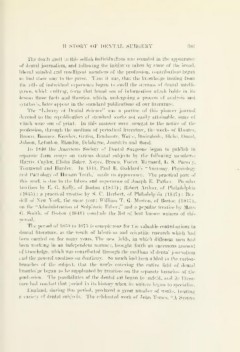Page 421 - My FlipBook
P. 421
HlS'l'OltY UF DENTAL SUEGEKY 381
The deatli knell to this selfish individualism was sounded in the appearance
of dental journalism, and following the initiative taken by some of the broad,
liberal minded and intelligent members of the profession, contributions began
to lind tiieir way to the press. Thus it was, that the knowledge issuing from
the rills of individual experience began to swell the streams of dental intelli-
ijence. which uniting, form that broad sea of information which holds in its
bosom those facts and theories, which, undergoing a process of analysis and
syntjiesis, later appear in the standard publications of our literature.
The "Library of Dental Science" was a portion of this pioneer journal
devoted to the republication of standard works not easily attainable, some of
v.iiich were out of ])rint. In this manner were brought to the notice of the
profession, through the medium of periodical literature, the works of Hunter,
Brown, Baunies, Koecker, Gariot, Berdmore, Waite, Desirabode, Blake. Duval,
Jobson, Lefoulon, Blandin, Delabarre, Jourdain and Bond.
In 1840 the American Society of Dental Surgeons began to publish in
separate form essays on variovis dental subjects by the following members^
Harris, Cuyler, Elisha Baker, Koyes, Brown, Foster, Maynard, L. S. Parmly,
Townsend and Hayden. In 1844, Paul B. Goddard's "Anatomy, Physiology
and Pathology of Human Teeth," made its appearance. The practical part of
this work is due to the labors and experience of Joseph E. Parker. Po])ular
treatises by E. G. Kelly, of Boston (1843); Robert Arthur, of Philadelphia
(1845) ; a practical treatise by S. C. Herbert, of Philadelphia (1847) : Bur-
dell of Xew York, the same year: William T. G. Morton, of Boston (1847),
on the "Administration of Sulphuric Ether;" and a popular treatise by Mavo
G. Smith, of Boston (1848) conclude tlie list of liest known writers of this
period.
The period of 18.j0 to 1875 is conspicuous for the valuable contributions to
dental literature, as the result of laliorious and scientific research which had
been carried on for many years. The new fields, in which different men had
been working in an independent manner, In-ought forth an enormous amount
of knowledge, which was contributed through the medium of denial journalism
and the general treatises on dentistry. So much had been added to the various
hi-anches of the subject, that the works covering the entire field of dental
knowledge began to be supplanted by treatises on the separate branches of the
profession. The possibilities of the dental art began to unfold, and its litera-
ture had reached that period in its history when its writers began to specialize.
England, during this period, produced a great number of works, treating
a variety of dental subjecls. The celebrated work of .John Tomes, "A System


